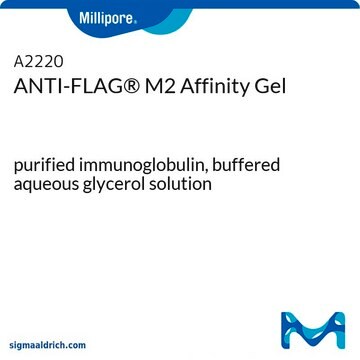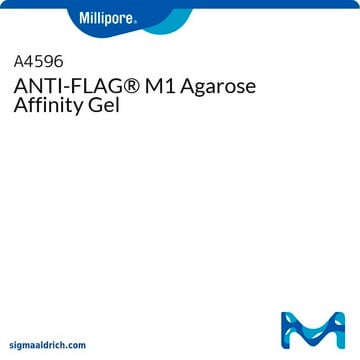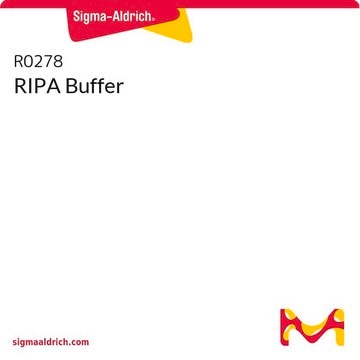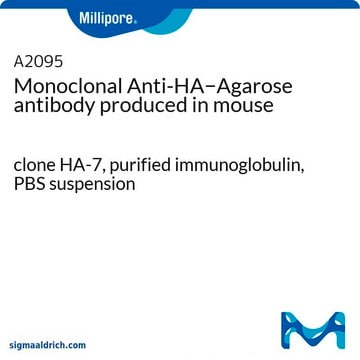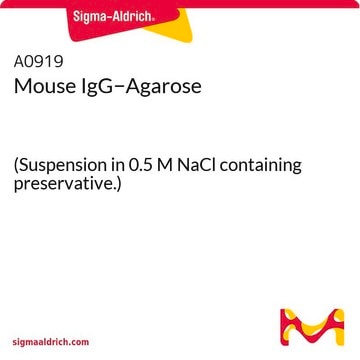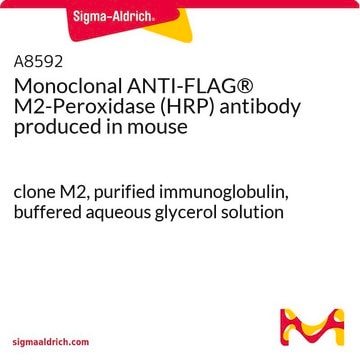As a result of the conjugation, there may be some M2 antibody that is not conjugated to the resin, but is associated with the resin and may appear in acid elutions as heavy and light chain when using the anti-mouse IgG conjugated secondary antibody. We recommend a acid wash (0.1 M glycine-HCL pH 3.5) and neutralization of the resin (do not allow the acid wash to sit on the resin longer than 20 minutes) prior to applying the lysate. Another way to avoid this is to use a directly conjugated FLAG antibody for detection such as product A8592 ant-FLAG M2 HRP, or the rabbit anti-FLAG polyclonal antibody, F7425.
F2426
ANTI-FLAG® M2 monoclonal antibody produced in mouse
clone M2
Sinónimos:
Anti-ddddk, Anti-dykddddk
About This Item
Productos recomendados
clon
M2, monoclonal
Nivel de calidad
clases químicas de analitos
proteins
técnicas
affinity chromatography: suitable
immunoprecipitation (IP): suitable
Matriz
4% agarose bead; 45-165μm bead size
isotipo
IgG1
capacidad
≥0.6 mg/mL, gel binding capacity
Condiciones de envío
wet ice
temp. de almacenamiento
−20°C
¿Está buscando productos similares? Visita Guía de comparación de productos
Descripción general
Especificidad
Aplicación
Elution - FLAG peptide, Glycine, pH 3.5, 3x FLAG peptide
Learn more product details in our FLAG® application portal.
Forma física
Información legal
Cláusula de descargo de responsabilidad
Producto relacionado
Código de clase de almacenamiento
10 - Combustible liquids
Clase de riesgo para el agua (WGK)
WGK 3
Punto de inflamabilidad (°F)
Not applicable
Punto de inflamabilidad (°C)
Not applicable
Elija entre una de las versiones más recientes:
Certificados de análisis (COA)
¿No ve la versión correcta?
Si necesita una versión concreta, puede buscar un certificado específico por el número de lote.
¿Ya tiene este producto?
Encuentre la documentación para los productos que ha comprado recientemente en la Biblioteca de documentos.
Los clientes también vieron
Protocolos
Protocol for immunoprecipitation (IP) of FLAG fusion proteins using M2 monoclonal antibody 4% agarose affinity gels
Contenido relacionado
Protein purification techniques, reagents, and protocols for purifying recombinant proteins using methods including, ion-exchange, size-exclusion, and protein affinity chromatography.
Protein purification techniques, reagents, and protocols for purifying recombinant proteins using methods including, ion-exchange, size-exclusion, and protein affinity chromatography.
Técnicas, reactivos y protocolos de purificación de proteínas para purificar proteínas recombinantes utilizando métodos como la cromatografía de intercambio iónico, de exclusión por tamaño y de afinidad.
Protein purification techniques, reagents, and protocols for purifying recombinant proteins using methods including, ion-exchange, size-exclusion, and protein affinity chromatography.
-
When using Product F2426, EZview™ Red ANTI-FLAG® M2 Affinity Gel clone M2, I see bands at 20-25 kDa and 50-60 kDa appearing in my Westerns that are not my FLAG-tagged protein. How can I prevent this?
1 answer-
Helpful?
-
-
What is the binding capacity of the Product F2426, EZview™ Red ANTI-FLAG® M2 Affinity Gel clone M2, resin?
1 answer-
The binding capacity of the resin must be ? 0.6 mg/mL to meet specifications. This capacity will vary from lot to lot.
Helpful?
-
-
When using Product F2426, EZview™ Red ANTI-FLAG® M2 Affinity Gel clone M2, I have a lot of non-specific proteins that are eluting with my FLAG-tagged protein. How can I get rid of these?
1 answer-
One way to remove non-specific proteins is to pre-bind the protein lysate with unconjugated resin. We recommend product 4B200 for this purpose. Other methods would be to increase the stringency of the washes by increasing salt concentration (the resin can tolerate up to 1M NaCl) or including detergents that are compatible with the resin.
Helpful?
-
-
What is the Department of Transportation shipping information for this product?
1 answer-
Transportation information can be found in Section 14 of the product's (M)SDS.To access the shipping information for this material, use the link on the product detail page for the product.
Helpful?
-
-
When using Product F2426, EZview™ Red ANTI-FLAG® M2 Affinity Gel clone M2, how can I elute my protein?
1 answer-
Elution with the peptide is the most gentle method. Acid elution (0.1 M glycine-HCL pH 3.5) is a more stringent method of elution, and should be evaluated for its effect on your protein if it is to be used in downstream applications. Boiling the resin in sample buffer is the most denaturing condition. If this condition is used, the resin cannot be re-used, due to the presence of SDS and/or reducing agents.
Helpful?
-
-
When using Product F2426, EZview™ Red ANTI-FLAG® M2 Affinity Gel clone M2, should I use a 3X FLAG peptide or a 1X FLAG peptide to elute my protein?
1 answer-
If you have a 3X FLAG-tagged protein, then you will need to use the 3X FLAG peptide. If you have a 1X FLAG-tagged protein, you can use the 1X FLAG peptide or the 3X FLAG peptide. We have not noticed a significant difference in elution efficiency by using a 3X FLAG peptide on a 1X FLAG-tagged protein.
Helpful?
-
Active Filters
Nuestro equipo de científicos tiene experiencia en todas las áreas de investigación: Ciencias de la vida, Ciencia de los materiales, Síntesis química, Cromatografía, Analítica y muchas otras.
Póngase en contacto con el Servicio técnico